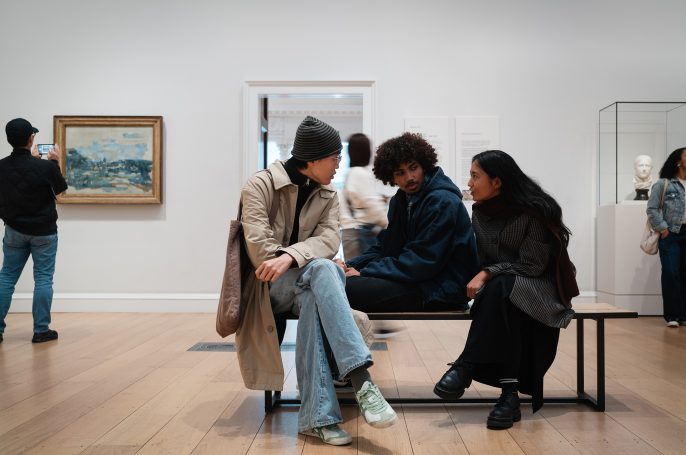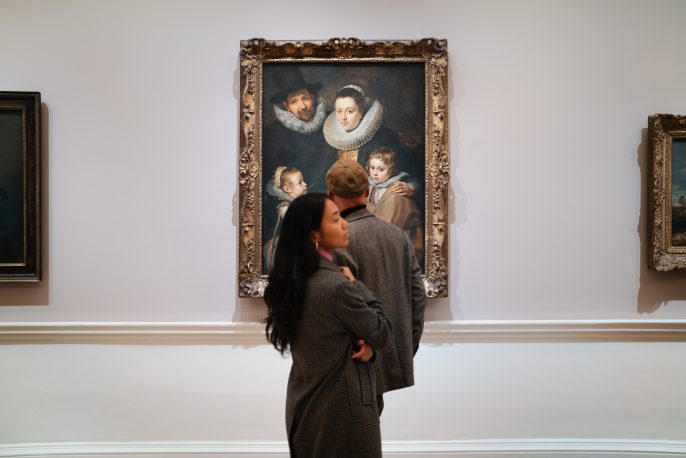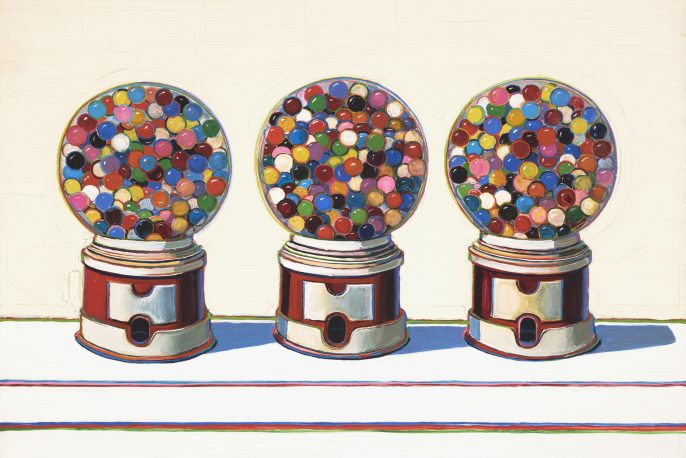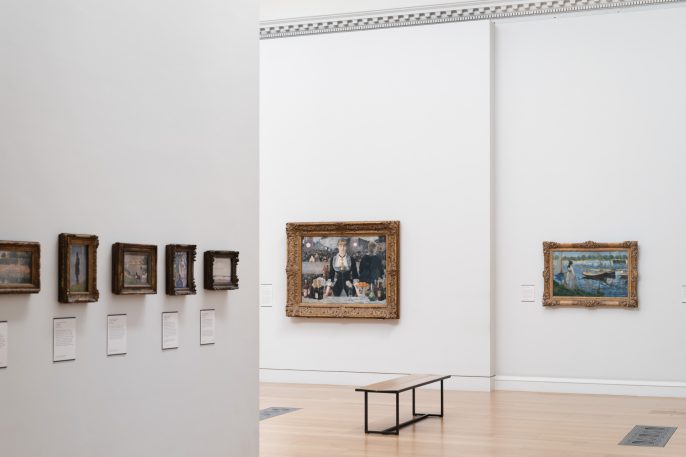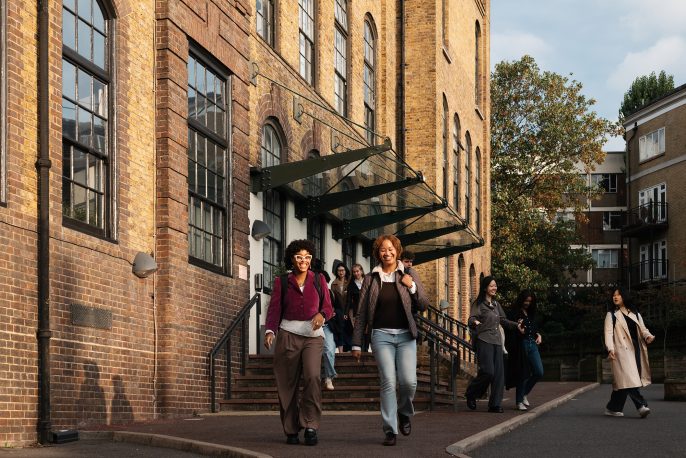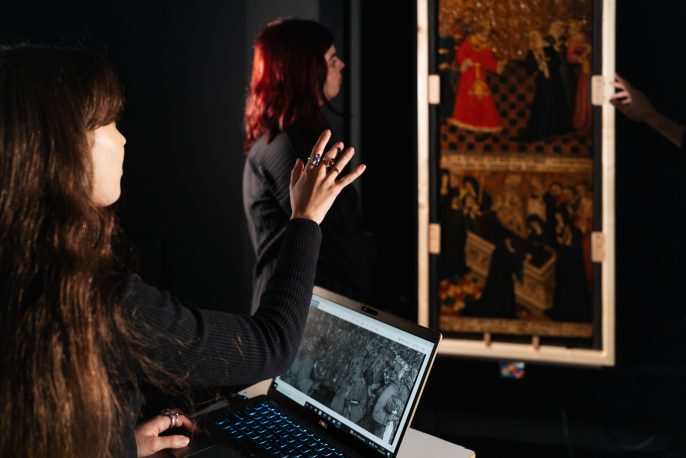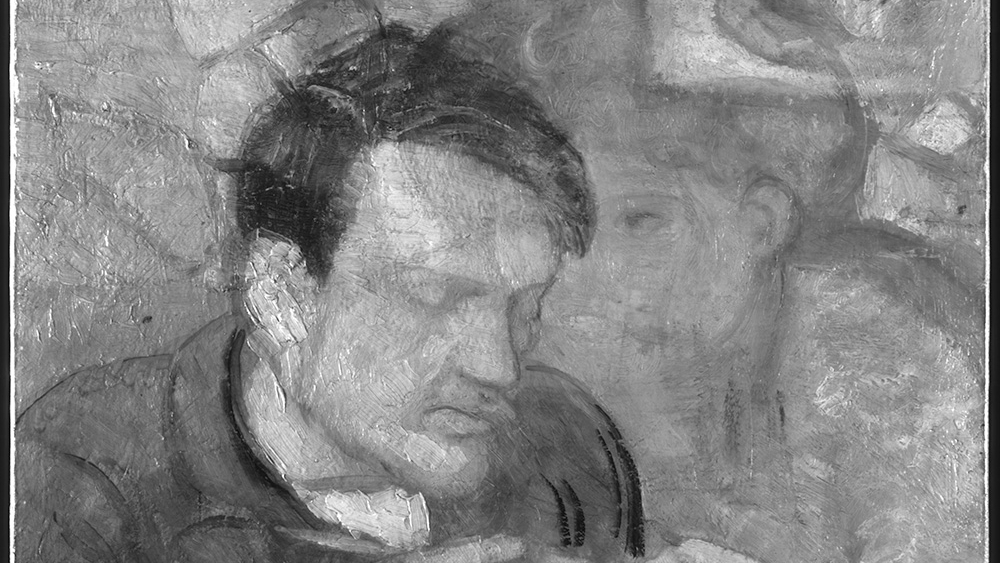
Hidden Picasso portrait discovered beneath important painting from his Blue Period
Who is the mystery woman revealed by technical imaging underneath Pablo Picasso’s Blue Period portrait?
Painting to be exhibited at The Courtauld Gallery as part of new exhibition The Griffin Catalyst Exhibition: Goya to Impressionism.
Masterpieces from the Oskar Reinhart Collection, opening 14 February
Download press images: https://tinyurl.com/25w2rus9
An undiscovered painting by Pablo Picasso (1881-1973) of a mystery woman, hidden for more than a century beneath one of the very first paintings from the artist’s famous Blue Period, has been revealed by conservators at The Courtauld Institute of Art, London, using specialist imaging technology to examine the work for the first time.
Conducted in collaboration with the Oskar Reinhart Collection, ‘Am Römerholz’, Switzerland, the unknown artwork was discovered when The Courtauld took x-ray and infrared images of Portrait of Mateu Fernández de Soto – a portrait depicting Picasso’s sculptor friend painted in 1901 and one of the earliest examples of the artist’s Blue Period – ahead of its display as part of the upcoming exhibition The Griffin Catalyst Exhibition. Goya to Impressionism: Masterpieces from the Oskar Reinhart Collection, opening 14 February.
The Courtauld’s analysis of the painting reveals it played an important role at a crucial stage in the young Picasso’s stylistic development, at a time when he was moving away from colourful, Impressionistic paintings towards a distinctly more melancholy artistic style which became the defining phase of his career known as his Blue Period.
Portrait of Mateu Fernández de Soto is emblematic of Picasso’s sombre Blue Period, hailed as a defining moment in his career. Nineteen-year-old Picasso had arrived in Paris from Spain in May 1901 for his first exhibition in the city, which opened at the gallery of the modern art dealer Amboise Vollard the following month. Picasso made a range of paintings for that show in an Impressionistic style, with lively brushwork and bright colour. However, by the Autumn of 1901, when he painted Portrait of Mateu Fernández de Soto, Picasso began to change his artistic style to an approach that was more contemplative and sombre, painted in tones of blue.
This Blue Period was inspired in part by the suicide earlier that year of Picasso’s good friend Carlos Casagemas. Picasso took over the rooms where Casagemas had lived in Paris and set up his studio there. Another friend, the young Spanish sculptor Mateu Fernández de Soto, arrived in the city in the Autumn of 1901 and was staying in this studio with Picasso where this portrait was made. The painting on the wall in the background of Portrait of Mateu Fernández de Soto is one of Picasso’s memorial paintings depicting the burial of Casamegas.
Infrared and x-ray images beneath the contemplative portrait of de Soto have revealed another figure, a painting of a woman, likely created just a few months earlier. The form of her head, curved shoulders and the fingers can clearly be seen. Wearing a distinctive chignon hairstyle, fashionable in Paris at the time, she bears a resemblance to several paintings of seated women that Picasso made that year, such as Absinthe Dinker (Hermitage Museum, St Petersburg) and Woman with Crossed Arms (Kunstmuseum, Basel). There is also evidence of a further head at an even lower level in the painting, suggesting it was a much-reworked canvas. She might have been a figure painted in his earlier Impressionistic style, akin to the painting of a woman in shimmering colours called Waiting (Picasso Museum, Barcelona).
Further research into the painting and detailed analysis could reveal more about the mystery woman, but it is not certain her identity will be established. She may have been a model, a friend or even a lover posing for one of Picasso’s colourful Impressionistic images of Parisian nightlife, or a melancholic woman seated in a bar.
Picasso often reused his canvases at this time because he did not have much money. However, he also embraced the process of painting one work over another, resisting whitewashing old images in favour of beginning a new figure directly on top of an earlier one. It is as if the portrait of de Soto grew out of the figure of the woman below as one style gave way to another.
Kerstin Richter, Director of the Oskar Reinhart Collection “Am Römerholz,” said: “This is truly a picture of great complexity, revealing its secrets over the years. When Oskar Reinhart acquired it in 1935, it was simply considered to be a portrait of an unknown woodcarver. Now we not only know the personality depicted, his significance in Picasso’s life after the death of his closest friend, but we can also visualise the artistic development process of the young painter layer by layer.”
Barnaby Wright, Deputy Head of The Courtauld Gallery, said: “We have long suspected another painting lay behind the portrait of de Soto because the surface of the work has tell-tale marks and textures of something below. Now we know that this is the figure of a woman. You can even start to make out her shape just by looking at the painting with the naked eye. Picasso’s way of working to transform one image into another and to be a stylistic shapeshifter would become a defining feature of his art, which helped to make him one of the giant figures of art history. All that begins with a painting like this.”
Aviva Burnstock, Professor of Conservation at The Courtauld, said: “Specialist imaging technology such as that used by conservators at The Courtauld may allow us to see the hand of an artist to understand their creative process. In revealing this previously hidden figure we can shed light on a pivotal moment in Picasso’s career.”
The exhibition’s lead sponsor is Griffin Catalyst, the civic engagement initiative of Citadel Founder and CEO Kenneth C. Griffin.
Courtauld Friends get free unlimited entry to all exhibitions, access to presale tickets, priority booking to selected events, advance notice of art history short courses, exclusive events, discounts and more. Join at courtauld.ac.uk/friends
The Griffin Catalyst Exhibition: Goya to Impressionism. Masterpieces from the Oskar Reinhart Collection
14 February – 26 May 2025
The Courtauld Gallery
Somerset House, Strand
London WC2R 0RN
Opening hours: 10.00 – 18.00 (last entry 17.15)
Temporary Exhibition tickets (including entry to our Permanent Collection and displays) – Weekday tickets from £14; Weekend tickets from £16.
Friends and Under-18s go free. Other concessions available
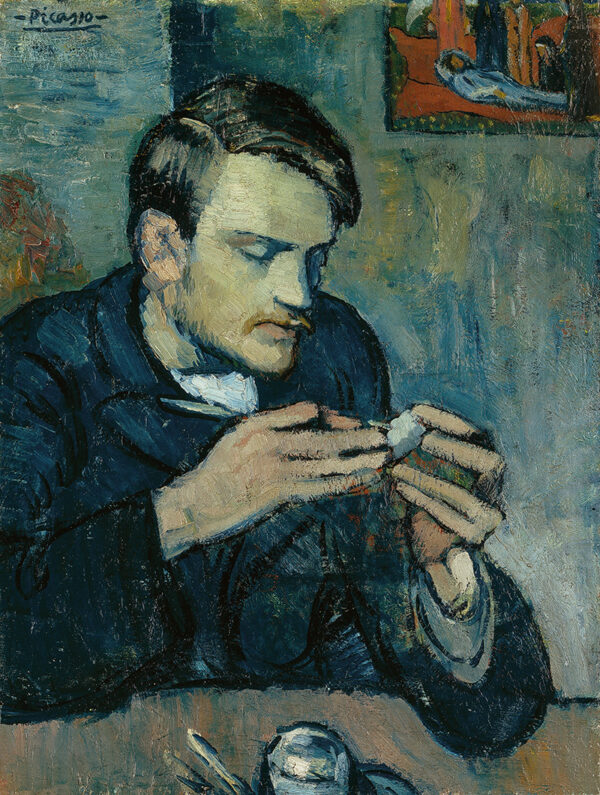
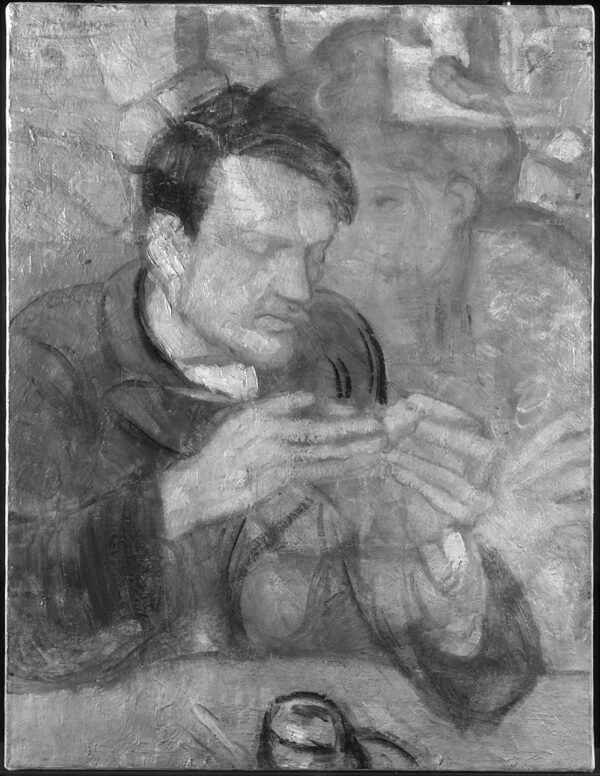
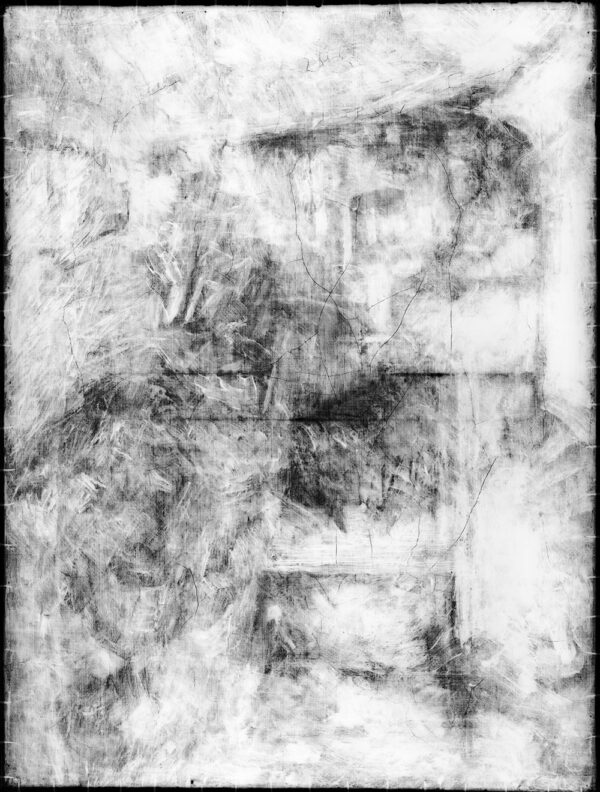
MEDIA CONTACTS
The Courtauld
www.courtauld.ac.uk/gallery/press
media@courtauld.ac.uk
Bolton & Quinn
Erica Bolton | erica@boltonquinn.com | +44 (0)20 7221 5000
Daisy Taylor I daisy@boltonquinn.com | +44 (0)20 7221 5000
SOCIAL MEDIA – THE COURTAULD
Facebook @TheCourtauld
Instagram @Courtauld #TheCourtauld
Threads @courtauld
TikTok @TheCourtauld
Twitter @TheCourtauld
YouTube TheCourtauld
SOCIAL MEDIA – THE OSKAR REINHART COLLECTION ‘AM RÖMERHOLZ’
Facebook @roemerholz
Instagram @roemerholz
NOTES TO EDITORS
About The Courtauld
The Courtauld works to advance how we see and understand the visual arts, as an internationally renowned centre for the teaching and research of art history and a major public gallery. Founded by collectors and philanthropists in 1932, the organisation has been at the forefront of the study of art ever since through advanced research and conservation practice, innovative teaching, the renowned collection and inspiring exhibitions of its gallery, and engaging and accessible activities, education and events.
The Courtauld cares for one of the greatest art collections in the UK, presenting these works to the public at The Courtauld Gallery in central London, as well as through loans and partnerships. The Gallery is most famous for its iconic Impressionist and Post-Impressionist masterpieces – such as Van Gogh’s Self-Portrait with Bandaged Ear and Manet’s A Bar at the Folies-Bergère. It showcases these alongside an internationally renowned collection of works from the Middle Ages and the Renaissance through to the present day.
Academically, The Courtauld faculty is the largest community of art historians and conservators in the UK, teaching and carrying out research on subjects from creativity in late Antiquity to contemporary digital artforms – with an increasingly global focus. An independent college of the University of London, The Courtauld offers a range of degree programmes from BA to PhD in the History of Art, curating and the conservation of easel and wall paintings. Its alumni are leaders and innovators in the arts, culture and business worlds, helping to shape the global agenda for the arts and creative industries.
Founded on the belief that everyone should have the opportunity to engage with art, The Courtauld works to increase understanding of the role played by art throughout history, in all societies and across all geographies – as well as being a champion for the importance of art in the present day. This could be through exhibitions offering a chance to look closely at world- famous works; events bringing art history research to new audiences; accessible and expert short courses; digital engagement, innovative school, family and community programmes; or taking a formal qualification. The Courtauld’s ambition is to transform access to art history education by extending the horizons of what this is and ensuring as many people as possible can benefit from the tools to better understand the visual world around us.
The Courtauld is an exempt charity and relies on generous philanthropic support to achieve its mission of advancing the understanding of the visual arts of the past and present across the world through advanced research, innovative teaching, inspiring exhibitions, programmes and collections.
The collection cared for by The Courtauld Gallery is owned by the Samuel Courtauld Trust.
About The Oskar Reinhart Collection ‘Am Römerholz’
In his former home the art collector and patron Oskar Reinhart (1885-1965) left behind one of the most important private collections of the 20th century. Outstanding paintings of French Impressionism and its forerunners engage in a stimulating dialogue with masterpieces of older art. The two main collection groups correspond to this day more or less exactly to the two architectural components of the residence. On the one hand, there are a few Old Master paintings displayed in the villa of 1915, Oskar Reinhart’s former home, being visually attuned to their surroundings. On the other, there are works of French Impressionism and its immediate forerunners, which form the main focus of the collection and which Reinhart juxtaposed with examples of earlier art in the gallery building of 1925.
The Oskar Reinhart Collection ‘Am Römerholz’ ranges from Lucas Cranach the Elder, Bruegel, Chardin and Goya to Cézanne, van Gogh and early Picasso. The approximately 200 works of art also include masterpieces by Géricault, Manet, Monet and Toulouse- Lautrec, as well as entire groups of works by Delacroix, Courbet, Daumier and Renoir. Pursuing the aim of acquiring art based solely on aesthetic rather than historical and geographic criteria, Reinhart managed to gather a harmonious selection of European masterpieces that belongs among the finest of its kind worldwide. In an aesthetically unique way, the Oskar Reinhart Collection ʻAm Römerholz̕ enables visitors to trace the history of European art from the fourteenth to the early twentieth century in the form of a magnificent celebration of the art of painting, abetted by a group of drawings and some sculptures and textiles.
Additionally, the property is surrounded by a beautiful park with old trees and important sculptures. In summer, guests can order picnic baskets at the museum café and enjoy the silence of nature in Reinhart’s vast historical garden. Throughout the year, audio guides in five languages, special tours, painting workshops for young and old, and a wide range of activities for children are available.
About Griffin Catalyst
Griffin Catalyst is the civic engagement initiative of Citadel founder and CEO Kenneth C. Griffin, encompassing his philanthropic and community impact efforts. Tackling the world’s greatest challenges in innovative, action-oriented, and evidence-driven ways, Griffin Catalyst is dedicated to expanding opportunity and improving lives across six areas of focus: Education, Science & Medicine, Upward Mobility, Freedom & Democracy, Enterprise & Innovation, and Communities. For more information, visit griffincatalyst.org/
